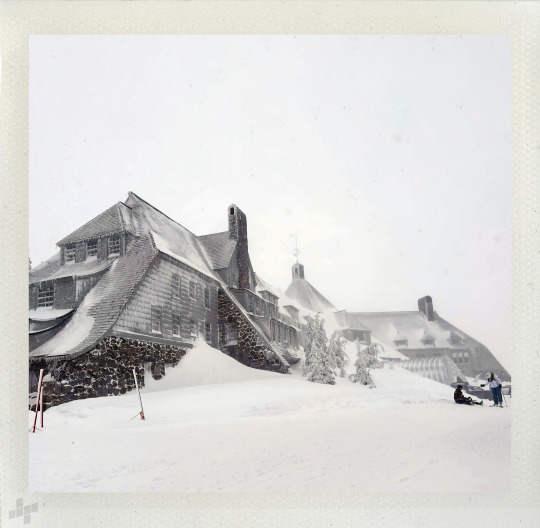#timberline lodge
Text
**book recommendations please***
I am staying at timberline lodge in a month (the outside inspo of the overlook hotel in the Shining movie and get ready for shining spam posts) and would love book recommendations please!
I am specifically looking for something like The Shining, creepy, snowy, ect.
I love Victorian gothics and would love something that direction with something wintery themed or present time is great too. Just look for something maybe slightly less pages than the shining, but a haunting-ish sort of thing please.
Thanks for any suggestions!!
*I've read the shining several times as well as doctor sleep**
9 notes
·
View notes
Text
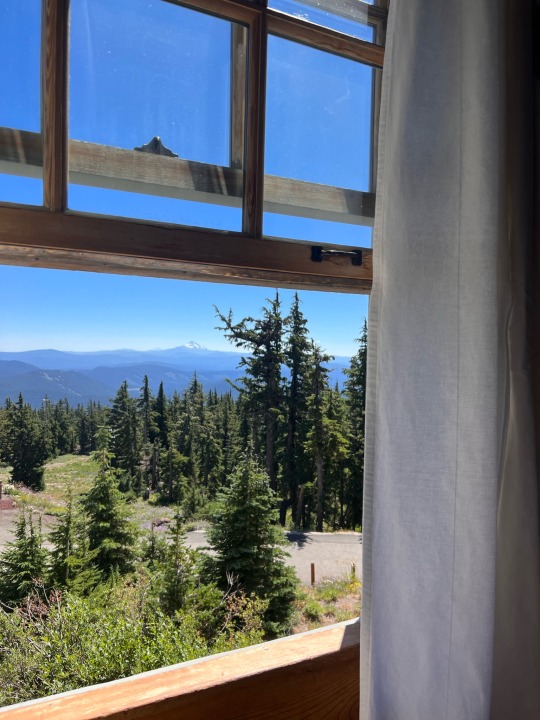
Home for the weekend ✨
#oregon#mine#pnw#pnwonderland#mt hood#timberline lodge#view from my window#mountains#green aesthetic#pnwlife
34 notes
·
View notes
Text
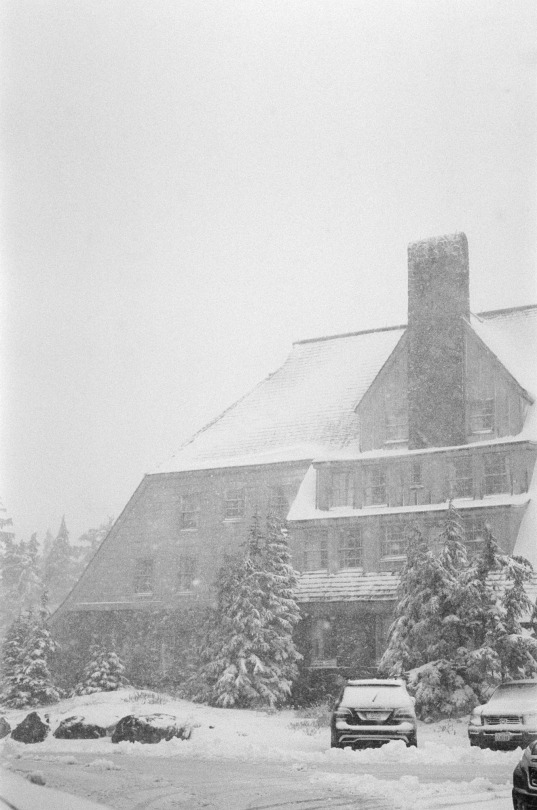
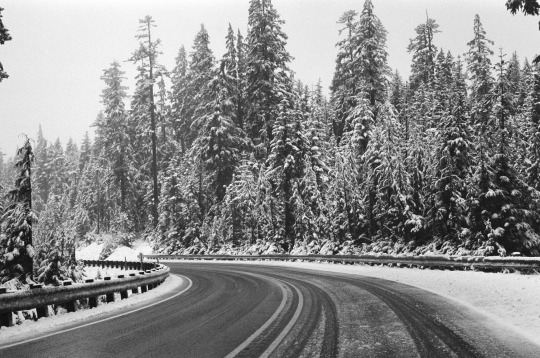
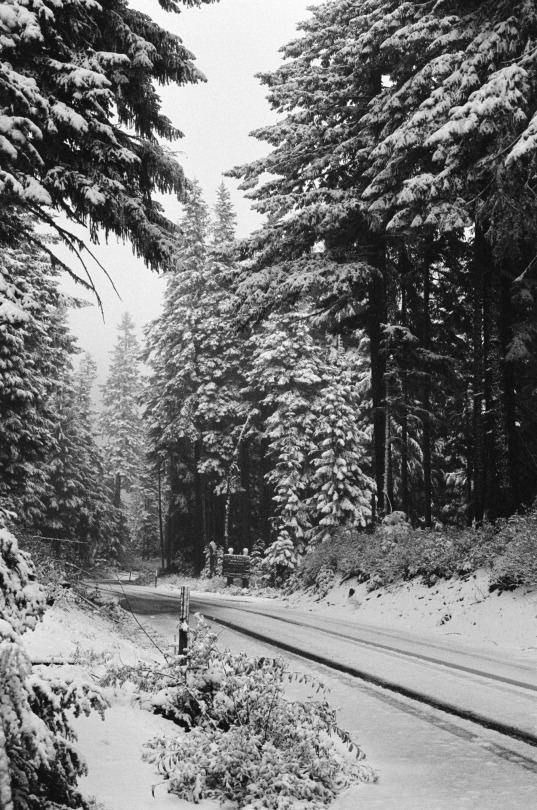


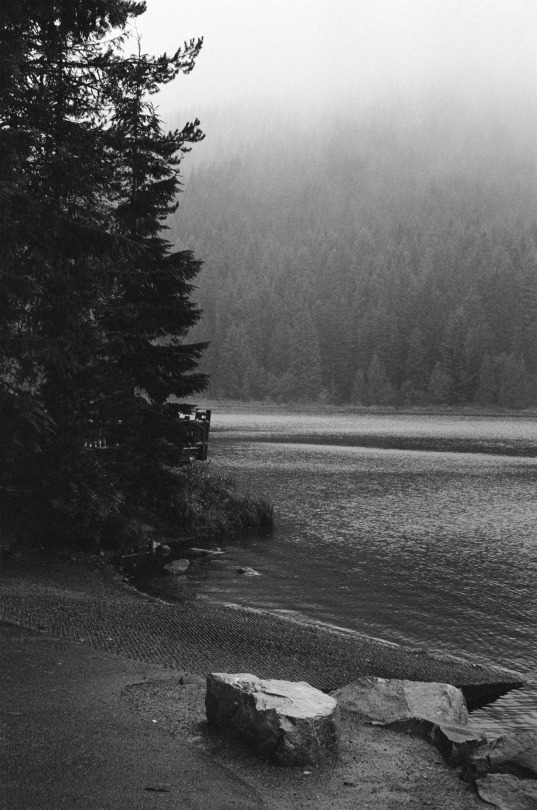
Mt. Hood, Oregon | October 2022
#mt hood#mt. hood#Oregon#timberline lodge#film#snow#35mm film#35mm black and white#35mm b&w#35mm#black and white#photography#canon a1#canon
4 notes
·
View notes
Text
The Pacific Crest Trail: A Visual Compendium
Howard reviewed Joshua M. Powell's creative treatment of his 2014 thru-hike back in June, 2021. His book is filled with interesting sidebar ("Mental Struggles," "Songs Stuck in My Head," "Things Found in the 1935 CCC Stone Hot on San Jacinto Peak," "Most Delicious Berries of the Trail," etc.).
Here are a couple of Joshua's asides:
Characteristics of a Great Trail Town
Directly on the trail or requiring only a brief detour or hitch
Compact and walkable, not too sprawling
Decent options in terms of food and lodging, but not so many as to be overwhelming
Scenic location
Charming atmosphere
Elements of Americana (neon signs, historic buildings, classic restaurants, friendly locals)
Best Trail Town
It's nearly impossible to choose a favorite, but considering the previous criteria: Cascade Locks, Oregon

Food
Most Memorable Breakfasts: Alabama Hills Cafe and Bakery, Lone Pine, CA; Morning Glory Cafe, Ashland, OR
Friendliest Service: Der Baring Store and Cafe, Baring, WA
Best Overall Food Experience: Timberline Lodge all-you-can-eat buffet, Government Camp, OR
Best Food Option in the Backcountry: Vermillion Valley Resort, Sierra Nevada
Only Meal I Couldn't Finish: Burrito at Roberto's Cafe, Mammoth Lakes, CA
What I Fantasized about Most on the Trail: An ice-cold Sprite from a soda fountain, fizzy with carbonation and chilled with ice

Dinner at VVR
We'll include some most from Powell's book in coming weeks.
#Trail Towns#Cascade Locks#Best Meals#Timberline Lodge#Baring WA#Lone Pine#Ashland#VVR#Vermillion Valley Resort
4 notes
·
View notes
Text





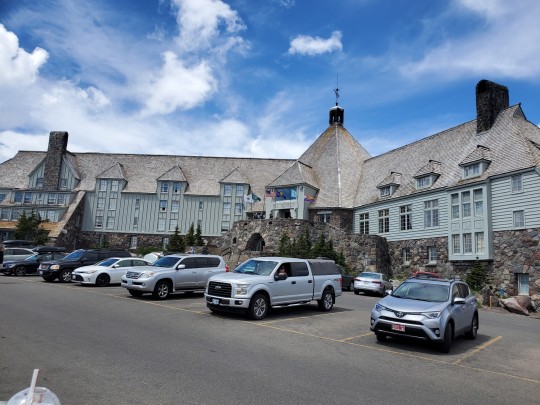
Went to the Timberline Lodge in Oregon. The exterior of The Shining was filmed here! It's only a few miles from the summit of Mount Hood and you can take a ski lift half way to the summit.
2 notes
·
View notes
Text

a man on the roof of timberline lodge
rppc ca. 1940s
0 notes
Text

Oregon Wildflowers on Mt. Hood
1 note
·
View note
Photo
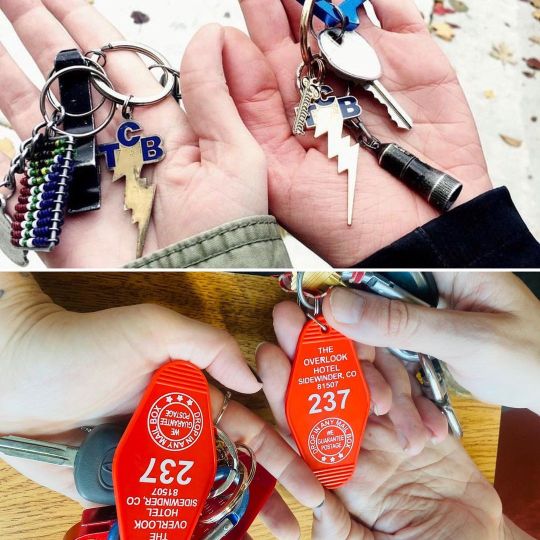


Now let’s forgive ourselves, our lives are long. 😎🏔😎 #2016v2022 #redrum #notvandnobeermakehomersomethingsomething (at Timberline Lodge) https://www.instagram.com/p/CgnzIHdOHrF/?igshid=NGJjMDIxMWI=
#2016 v 2022#redrum#the overlook hotel#timberline lodge#mt. hood#oregon#no tv and no beer make homer something something#personal#me#my face#friends#bts lyrics
0 notes
Text
About to be heading to oak lodge
2 notes
·
View notes
Text
Bolton Valley, VT 10FEB2024
A pair of skis and the lift attendant at the Timberline Mid Station give hints of a spring-like view to go with today’s temperatures and snow
Today was forecast the be the warmest day of this current stretch, and while there was a chance for showers, it was sunny most of the morning. We had an appointment in the afternoon, but with sunshine and valley temperatures expected to get into the 50s F,…
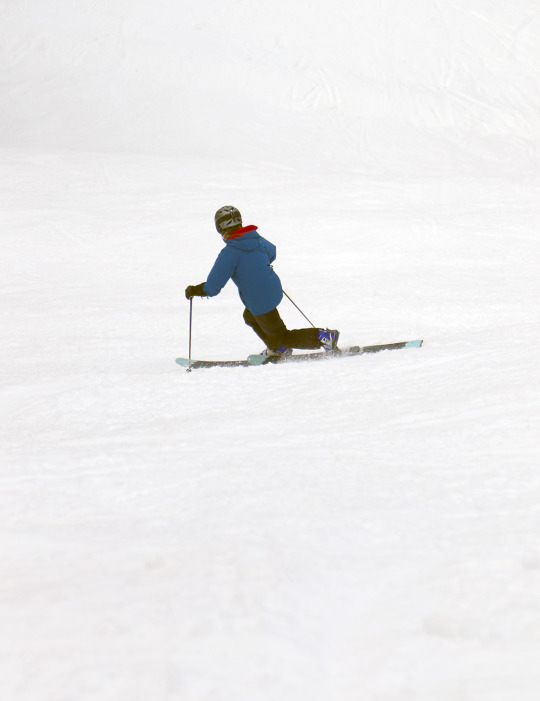
View On WordPress
#Bolton Valley#Corn Snow#February#Image#Intro#Northern Vermont#Photograph#Picture#ski#Skiing#Snow#Spell Binder#Spring#Telemark#Timberline#Timberline Area#Timberline Base#Timberline Base Lodge#Timberline Chair#Timberline Lift#Timberline Mid Station#Timberline Quad#Timberline Quad Chairlift#Timberline Summit#Trip Report#Twice as Nice#Vermont#Winter
1 note
·
View note
Text
Mount Hood


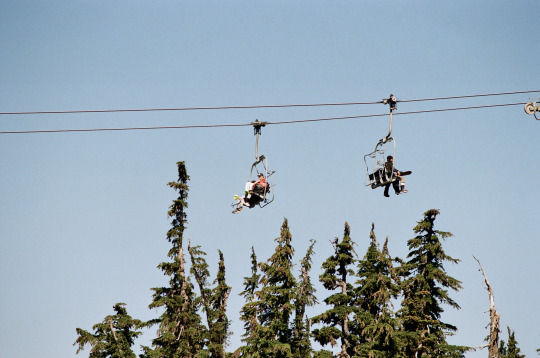

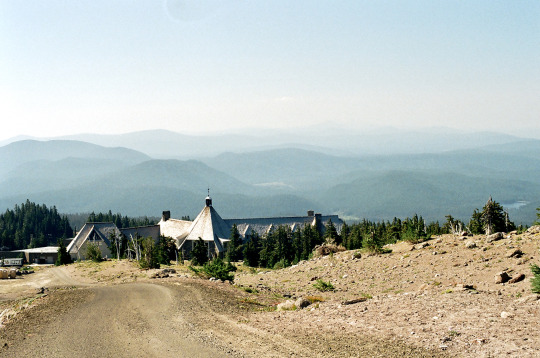
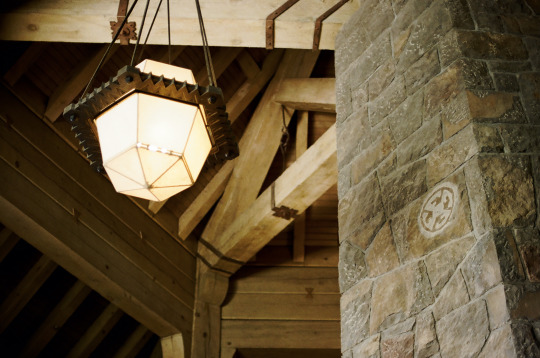
Mount Hood is the tallest peak in Oregon, over 11,240 feet. It's an active stratovolcano covered in glacial ice that last erupted about 240 years ago (in the 1780s, exact years unknown). The large crater that opens to the south near the summit was formed about 1,500 years ago, and the pinnacle standing in the middle - Crater Rock - was squeezed out like toothpaste in the most recent eruption (~240 years ago). The crater contains many active fumaroles and steam vents, hinting at the heat still within. The eruption that formed the crater is called the Timberline Eruptive Period. The collapse of the south face of the volcano deposited a huge debris fan that now appears as a gentle slope to the summit area. Timberline Lodge, a 1936 Works Progress Administration (WPA) project owned by the US Forest Service, is built on this debris fan and offers tremendous views of the southern glaciers, the summit cliffs, and the ski slopes that remain open to skiing through August most years.
These photos were taken in early August, 2022 on Kodak Gold film. Find more at my Flickr!
#oregon#geology#photography#pacific northwest#volcano#glacier#alpine#kodak#kodak gold 200#film photography#analog photography#my photgraphy#photographers on tumblr#mount hood#Nikon#high cascades#cascade mountains
68 notes
·
View notes
Text
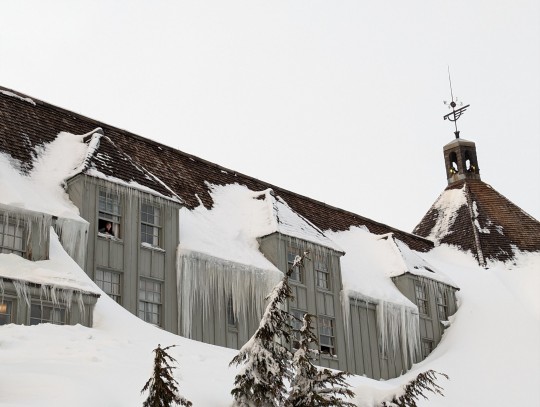
"Danny! The window is stuck"
1 note
·
View note
Text

Summer nights ✨
#oregon#mine#pnw#beautiful#love#pnwonderland#nature#pnwlife#sunset#mountains#ombré sky#beautiful day#thankful#sunset lover#mt hood#timberline lodge#hiking#let’s go outside#cascades#mountain range
4 notes
·
View notes
Text
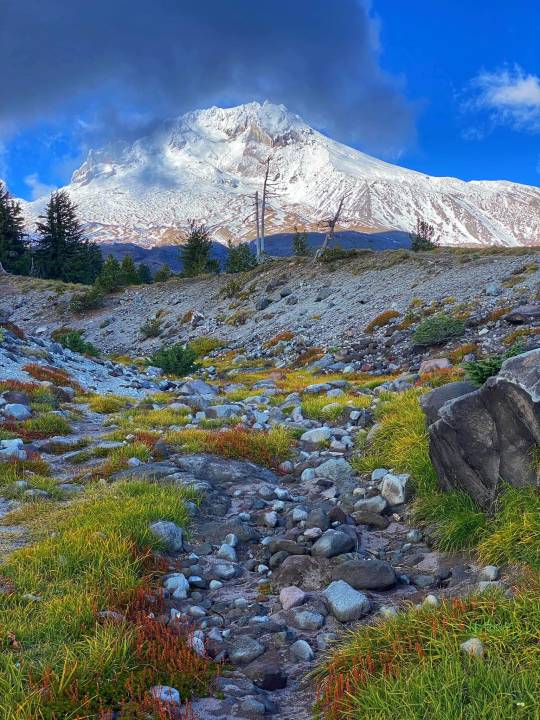
Gary Peterson
"The Big Reveal. After a week of stormy weather, Mt Hood has a very different look about her. Fall is in the air. Mt Hood from Timberline Lodge."
64 notes
·
View notes
Note
Hold a seminar and tell me all about The Shining
*cracks knuckles*
Let's go.
I'm going to break this down into discussion topics, though some things will overlap juuuuuuuust a leedle. First, we'll go over the plot, then the technical aspects of the movie, followed by themes and analysis, and conclude with all the unhinged raving I can put into words. I'll also try to avoid discussing the book too much because they are different animals (though not as different as some folks make them out to be), and try to keep to the film as much as possible. Continue at your discretion, as this is going to be a Very Long Post and we're going to discuss addiction, alcoholism, murder, suicide, domestic violence, and sexual abuse.
The Plot
youtube
Jack Torrance, would-be writer and recovering alcoholic, takes a job as the winter caretaker at the Overlook Hotel, a resort located in the Rocky Mountains. He moves his wife, Wendy, and young son, Danny, to the isolated hotel during the off season from November to May, looking forward to peace and quiet to help finish his latest writing project. However, Danny has a psychic gift called "shining," and begins to have horrifying visions of the hotel. It doesn't take long before the isolation and the hotel itself start getting their hooks into Jack, and he becomes more and more unstable. Is he losing his mind, or is the Overlook haunted? Are Wendy and Danny trapped with a madman or ghosts? And what does "redrum" mean?
Technical Aspects
The Shining film was adapted from the Stephen King book of the same name by Stanley Kubrick and Diane Johnson, and directed by Stanley Kubrick. And if you know anything about Kubrick, you know he remains one of Thee directors of all time. He was also a grade-A dick hole, but we'll get to that. Filming was done at Elstree Studio in England, with exterior shots done at Glacier National Park in Montana and the Timberline Lodge in Mount Hood, Oregon.
The first thing you need to know is that there was barely a functioning script the entire time they were filming. After hearing that Kubrick was interested in adapting his book, Stephen King drafted a screenplay himself--and Kubrick discarded it almost immediately. Rewrites were ongoing throughout production, with footage and photographs of Kubrick onset clacking away at his typewriter, and Jack Nicholson (cast as Jack Torrance) is on the record saying he didn't bother looking at the day's pages when they were delivered in the morning because they would be rewritten by the time they started shooting and he'd have to learn the lines again anyway.
Second, you might be tempted to think they filmed in a working hotel, but it's all one ginormous set built to scale on a sound stage. During preproduction, Kubrick sent crew members scouting out different hotels for design inspiration, so the Overlook we see in the film doesn't exist as one unit but a composite of many separate units. In addition to the aforementioned Timberline, the Ahwahnee Hotel in Yosemite National Park served as a starting point for interior designs. The hedge maze that features in the final act was built out of plywood walls and greenery, then covered in rock salt and crushed Styrofoam to make it look snowy. To give the effect of winter sunlight through the hotel windows, lights with a collective wattage of 750,000 to one million per window were used. No wonder part of the set caught fire toward the end of the shoot.
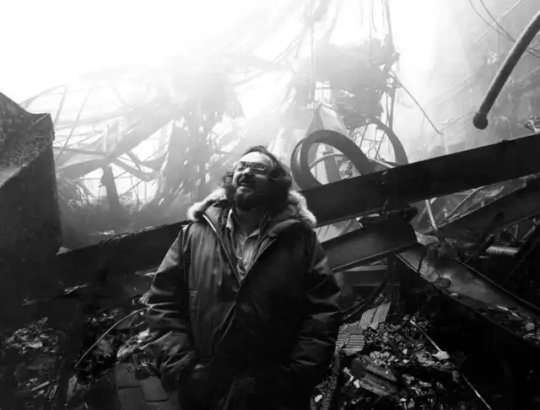
Why is he laughing, you ask? Well, it might have something to do with the ending of the story. In King's book, the hotel burns down at the end. In Kubrick's script, it's still standing when the movie is over. The set burning down after shooting?

Third, the cinematography. If I'm ever watching this and lose track of what's happening with the story, it's because I'm ogling what's happening on screen. Kubrick worked as a photographer before he got into film making, and hoo boy, it shows. The shot composition frequently uses one-point perspective and near perfect symmetry, giving us shots like these:

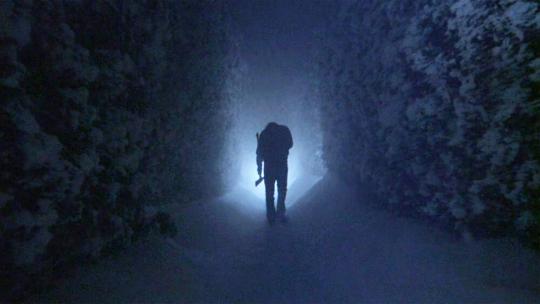
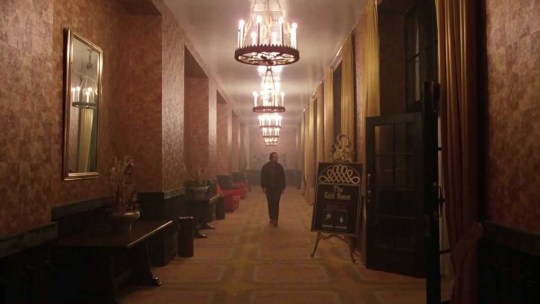
Static images don't do it justice, though, because Stanley was using this newfangled contraption called a Steadycam. Previously, camera operation required dollies and tracks to stand and move, which took time to set up and didn't always flow smoothly. The Steadycam was smaller and lighter, the height could be adjusted much more easily, and could be strapped to the camera operator and allow them to move freely, with the resulting POV feeling more and more like the hotel itself is alive and stalking the occupants.
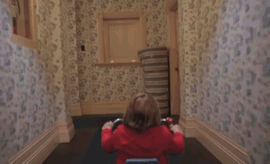


Also, that carpet? I'm obsessed with it. It's garish and loud and it gives me joy. One of my favorite details is how often chandeliers end up just so in the frame to crown the characters beneath them. Another is the touch (and sometimes more) of red in nearly every frame. Let me also direct your attention to this bit of foreshadowing:
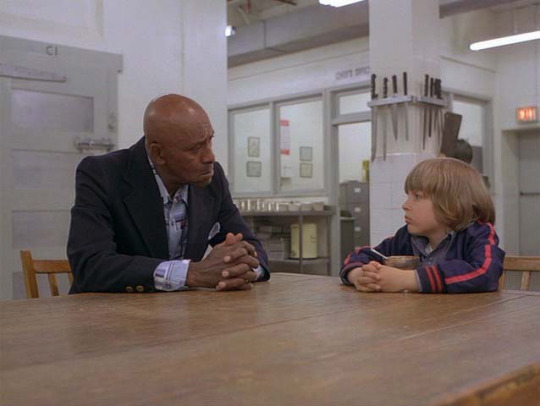
We cut to this shot immediately after Danny asks head chef Dick Hallorann, who also has the shining, if there is anything bad at the hotel. See those knives hanging above him?

We gotta talk about the sound design and the score, because this would be a Very Different movie without it. I'm going to split hairs and argue that this film does NOT have a proper score, but it does have a very effective, very nerve-wracking soundtrack. How so? Well, there are exactly two original pieces of music in the entire movie, both written by Wendy Carlos.
If that main theme sounds kinda familiar, it's based on Dies Irae, which is always cool. The rest are all various pieces by composers ranging from Béla Bartók to Krzysztof Penderecki, and are apparently unedited to fit the movie. The pieces chosen just happened to sync almost perfectly. In certain scenes, there are even multiple pieces playing at once, overlaid on top of each other, for an even more discordant, chaotic effect.
And let's not forget the number that proved to me once and for all how cozy-creepy old timey music can be, though it's far from the only old-timey number used:
You can't stress enough how important good sound design is, especially in horror, and this stuff is glorious. *chef kiss* This is a quiet movie except for when it isn't, and the overall stillness gives the noise, when there is any, greater weight. One of the more talked about examples is of Danny riding his tricycle through the hotel, going over hardwood, then carpet, then hardwood, etc. It's the only noise in the scene, and the abrupt switching of the wheels rolling loudly over wood to softly over carpet does so much for the tension. The one that gets me, though, is the sound of the wind. There's a storm outside for the second half of the movie, and if you can hear nothing else in any scene, you can hear it howling. It's lonely, it's dreadful, and it's unforgiving. That detail more than anything else drives home for me that the Torrance family is on their own, at the mercy of the elements and the Overlook.
Probably the only one having a good time on set was Danny Lloyd as Danny Torrance, in one of his only film appearances (though he would cameo years later in the sequel Doctor Sleep). Child labor laws restricted the hours he could work and a lot of effort went into making sure he was never exposed to anything inappropriate or traumatic. As a result, he never even knew he was making a horror movie. The rest of the cast didn't get off so easy, and now we get to the part about Stanley Kubrick being a grade-A dick hole. Notorious for insisting on dozens of takes, he already had a track record of putting his actors through hell while filming, and this shoot is the most infamous of them all. Scatman Crothers (Dick Hallorann), in his seventies by the time filming started, broke down in tears after having to redo a scene over one hundred times. After forty takes of a scene between Dick and Jack, Nicholson had to step in and insist Kubrick move on, as it was getting to be too much for Crothers. As for Nicholson, he was only allowed to eat cheese sandwiches for two weeks to get him in the agitated state Kubrick was aiming for. Worst of all was Shelley Duvall's treatment. By most accounts, Kubrick pushed method acting onto her until she was as stressed and exhausted on set as her portrayal of Wendy is on film. They fought constantly, with Kubrick not only telling her she wasn't convincing enough and she was wasting everyone's time but also forbidding anyone on set from showing her any kind of support or sympathy. Duvall was frequently dehydrated on set after reshooting scenes of her crying so many times she couldn't produce any more tears, and by the time filming wrapped, she was literally losing hair from stress. She gave an interview admitting to hating Kubrick during production, but otherwise respected him.
And now that we've covered the nerdy shit...
Themes and Analysis
Spoilers ahead!
This is a story about the cycles of violence and abuse. That's the basic, easy summary that anyone who watches the movie could give you (well, maybe not... Room 237 exists, after all). Jack Torrance is a man who, while able to put on a charming facade long enough to land a job, has a couple marks against him before the Torrances ever get to the Overlook. As stated above, Jack is an alcoholic* only five months sober after losing his temper in a drunken rage and dislocating Danny's shoulder.
*This is not in any way suggesting that alcoholism is the root of Jack's problems and is to blame for every bad thing that happens. This was the change from the book that King objected to the most, where book!Jack is a decent guy and a sympathetic character who fights tooth and nail to resist the Overlook's power before being overcome. It's not his fault, he has an addiction, etc. Kubrick took that and hucked it out the window. Movie!Jack has the same addiction, but it's never once used as the scapegoat to excuse his behavior. One version is an asshole because that's what the hotel turned him into after exploiting his weaknesses, the other is simply an asshole. Is the hotel manipulating him? Well, yes, because that's what it does, but you never doubt his agency throughout.
During Jack's interview with the hotel manager, we learn a previous caretaker lost his mind over the winter and killed himself and his entire family. So within the first fifteen minutes, we know exactly how this will play out: Jack, who has already abused his son once before, will go crazy and try to kill his family. It's not just that abusive people tend to keep up patterns of abuse, it's also that history generally tends to repeat itself in broad strokes. Jack has hurt Danny before, and he will do it again. A caretaker has slaughtered his family once, and a caretaker to follow will do the same.
Let's talk about this scene:

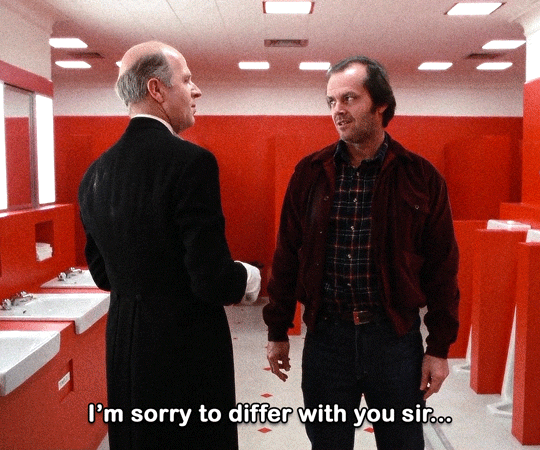

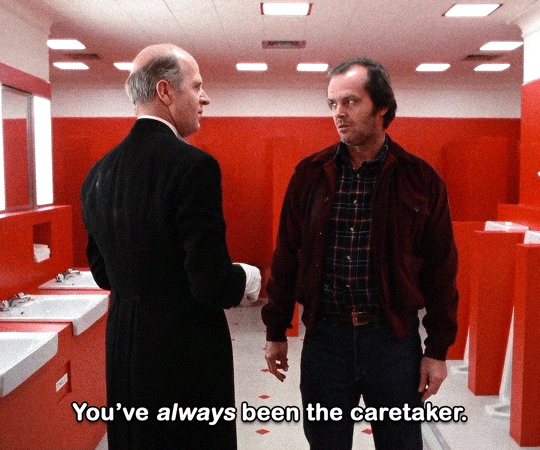
We can take this to mean a few things. Time doesn't really matter at the Overlook, because everything moves full circle anyway. True, Jack Torrance has only been on the job for about one month at this point, but him being Jack Torrance is less significant than him being the caretaker, and the caretaker has always been the caretaker. He's talking to Delbert Grady, a member of the hotel staff back in the 1920's--NOT Charles Grady, the caretaker who murdered his family, but again, time doesn't matter. It's not about the individual in the role, but the role itself. It only matters as far as Jack's perception is concerned, and Jack thinks he's talking to his predecessor. Crucially, Kubrick breaks the 180-degree rule in this scene.
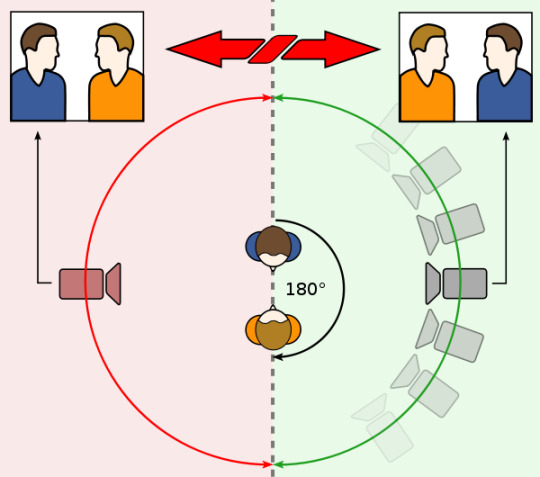
The gist of the rule is, to avoid disorienting the viewer, the camera should only move 180° in relation to the characters. Whoever is on the left side of the frame should stay on the left, and vice versa. Jack and Grady, however, occupy both sides of the frame depending on the angle. As far as the viewer is concerned, both men effectively take up the same space. And given that neither time nor identity matter, they both occupy the same roles: each is both murderous caretaker and manipulative force inciting violence. And the cycle continues on.
Now let's cycle (see what I did there?) back to alcoholism. As I said before, Kubrick takes a different approach to it, and anyone who tries to say he cuts down its significance to the plot is clearly not paying attention. Jack is an asshole plain and simple, and Wendy's reaction to the way he berates her for interrupting his writing is indication enough that it's far from the first time he's been verbally abusive. He doesn't need to drink to be a dick. However. He does not become a physical threat until after he starts drinking. He was drunk when he hurt Danny, and it's only once he's been to the hotel bar that he decides to kill his family. That's an important distinction, if you ask me. His habits never serve as an excuse for his behavior, but they are relevant to the danger he poses to Wendy and Danny. Consider, the Overlook lures him in with his favored vice at a moment when he's already under pressure and sobriety is unappealing. He wanders into the Gold Room (in one of my favorite shots of the whole movie, btw), sits down at the bar and says "I'd give anything for a drink. I'd give my goddamn soul for just a glass of beer." Then lo and behold, the Overlook delivers and Lloyd the bartender appears.
Except...the Overlook doesn't quite deliver the way Jack expects it to. He orders bourbon, and Lloyd gives him whiskey. In room 237, he thinks he's found a beautiful young woman who wants to jump his bones, but she's actually an old, rotting corpse. Whatever Jack thinks he's going to get for killing his family, the hotel is never going to pay up. (I guess buddy boy forgot the part where Grady committed suicide after he "corrected" his wife and daughters.) Jack buys into the game without considering he'll never be allowed to walk away from the table. Regardless of what happens to Wendy and Danny, Jack is going to die at the hotel, and the cycle will continue. It's all very Shakespearean...
And speaking of Shakespeare, we've got Hamlet's classic "are the ghosts real or is he just crazy" scenario playing out. You can argue that Danny's visions are just in his imagination, and that Jack is hallucinating all of his encounters. You could even pin Wendy's haunted house trip in the final act on the amount of stress and fear she's having to push through to save herself and her son. Everything is just ambiguous enough that it's almost believable to attribute it to cabin fever induced psychosis. Buuuuuuuuuuuuut, you can't explain away how Jack escaped from a locked pantry on his own, a detail that Kubrick and Johnson got hung up on when writing the script. Kubrick wanted the haunted-or-hallucinating question left up to interpretation as much as possible, but there was no way around it for getting Jack out of a locked room so he could go on his rampage. The ghosts have to be real so Grady can let Jack out. If you're dedicated to the idea that nothing supernatural is happening, it's not hard to ignore it, though. Just ask the folks interviewed for Room 237.
Unhinged Raving
We're almost done! I promise!
Shelley/Wendy Defense Squad
Let's get this out in the open right now: I will fight to the death over Wendy Torrance and Shelley Duvall. No actor deserves to have a performance harassed out of them, no matter what vision the director has. Actually, Duvall got a shitty deal right from the get-go if you factor in that Kubrick cast her because his vision of Wendy was "mousy." Yeah, I get it, his take on Jack would have been incompatible with King's original presentation of Wendy, but really? Mousy? She's beautiful and I won't hear a word otherwise. And I know, I knowwwwww, everybody's a critic, but anyone who can watch her in this and say she's giving a bad performance is clearly not watching the same movie I am, and I'M TALKING TO YOU, STEVE. WE SAW WHAT HAPPENS WHEN YOU'RE IN CHARGE OF ADAPTATIONS OF YOUR OWN WORK, AND IT'S NOT GOOD. (Glad you had fun, tho, good for you, etc etc.) ANYWAY. This movie only works because of her, and I stand by that. Jack is only scary because you can see how afraid Wendy is. The scene with the bat doesn't get me because Jack is menacing. He is, don't get me wrong, but I've seen an angry man yelling at me I don't know how many times, and it's not impressive anymore. But the sheer terror in her face as she tries to back away from him, too scared to let him out of her sight and yet still unwilling to fight back until he gives her no choice? Dude. If that doesn't have me crying for her, then her screaming as Jack breaks down the bathroom door later on does.
Why Room 237 Is A Load Of Horse Shit
I've referenced Room 237 twice, so I might as well talk about it. It's a documentary made around all the various conspiracy theories about the movie. If that sounds interesting, let me save you some brain cells:
1. This movie is about the Holocaust - evidence for this one includes Jack using an Adler typewriter, which was apparently the favored model of the Nazi party, and recurring instances of the number 42, referencing the year 1942.
2. This movie is about how Stanley Kubrick helped the government fake the moon landing - evidence includes Jack ranting about how he signed a contract, the iconic carpet pattern looks like an aerial view of the shuttle launch pads, the noted room number which was changed from the book's 217, and Danny's Apollo 11 sweater.
3. This movie is about the genocide of Native Americans - evidence includes a throwaway line about the Overlook being built over a native burial ground, various iconography used in the hotel's interior, and the color palettes worn by the Torrance family in the third act.
4. This movie is a retelling of the myth of the Minotaur - evidence includes the hotel maze, which doesn't appear in the book, and a poster of a minotaur hanging in the game room.
(These next two aren't in the documentary, but are discussed enough that I'm including them.)
5. This movie is about a parent sexually abusing their child - evidence includes Jack reading a copy of Playgirl in the hotel lobby, Danny's Apollo 11 sweater, and the ghost in the bear costume.
6. This movie is about schizophrenia - evidence includes furniture moving between takes.
Those are the theories, and here is why they're wrong:
1. If Kubrick had wanted to make a movie about the Holocaust, he would have. He'd already done multiple war dramas at this point in his career, so there was nothing stopping him. Multiple typewriters are used throughout the movie, including the Adler model, and they were constantly swapped out to add to the visual disorientation. The number 42 on Danny's jersey is referencing Jackie Robinson, the baseball player. The forty-two cars in the hotel parking lot had nothing to do with Kubrick, as he wasn't even present for the location shots. I'll bet money that Wendy swinging the bat at Jack forty-two times was incidental, given how many times they filmed that scene over and over. And Wendy watching the movie Summer of 42 is likely what inspired the hunt for other 42s to back up the theory.
2. What's important about Danny's sweater is that it looks homemade, therefore it's more emotionally jarring that it gets damaged later. Space and astronauts were popular with kids, so it would make sense for him to have a space sweater. The room number was changed from 217 because the Timberline had a room of that number and, worried that its appearance in a horror movie would drive away guests, requested that it be changed--not because the supposed distance between the earth and the moon is 237,000 miles (it's further, actually, so it's even more wrong).
3. Ever heard of The Amityville Horror? The film had come out a few years prior to this one and plausibly popularized the house-is-haunted-because-burial-ground trope. Kubrick's sense of humor is ironic enough that I have no trouble believing this nonchalant line, from a scene that's missing from Kubrick's favored cut of the movie, no less, is meant to be an ironic jab at this trope. The artwork in the hotel, the interiors of which were inspired by existing hotels in western America, is incidental because it exists in the inspo. And yes, Wendy and Danny wear earth tones while Jack wears red and blue while he's trying his best to kill them, but this is less likely a commentary around the mistreatment of Native Americans at the hands of colonizers and more likely a visual inversion of how everyone was styled at the beginning of the movie.
4. The hedge maze exists because it was easier to pull off than the topiary animals that come to life in the book. The poster that's referenced is a poster of a skier, advertising a ski resort. It could look a little less like a skier and a tiny bit more like a minotaur, I guess, if you squint.
5. Yeah. Sure. Kubrick included a recent (at the time) porno magazine that featured an article about incest on the cover because he knew viewers would one day be able to zoom in on it and identify it and know this movie was about incest. Bears are slightly associated with Danny throughout the movie and he wears a sweater with a phallic shape on it because when you get to the part with a guy in a bear costume giving a blow job, it becomes SO OBVIOUS that this means Jack is molesting his son. Get the fuck out of here. If Kubrick wanted to make a movie about the sexual abuse of a child, he would have. Oh wait, that's right, he had already adapted Lolita, and look how that turned out!
6. CONTINUITY ERRORS, PEOPLE. THE FURNITURE MOVES BECAUSE OF CONTINUITY ERRORS. BARRING THAT, IT ONCE AGAIN CONTRIBUTES TO THE VISUAL DISORIENTATION. "Oh, but Kubrick was a genius, he didn't make mistakes, everything is deliberate" SHUT UP. SHUT THE FUCK UP. IF EVERYONE THINKS YOU'RE A GENIUS, YOU NEVER HAVE TO ADMIT TO A MISTAKE EVER AGAIN. JESUS FUCKING CHRIST ON A CRACKER.

...anyway.
My Favorite Shots
I'm gonna geek out about these because *chef kiss*

It's the sudden swing and stop as the camera follows the axe that does it for me. Fun fact #1, that's Kubrick himself behind the camera. The shot was important enough he didn't trust anyone else with it. Fun fact #2, Jack Nicholson was a former volunteer fire fighter, and therefore knew how to break down a door. After he destroyed the prop doors too easily, they had to bring in real ones for him to hack at instead.

Look at that composition. Something about the way she cries as the axe gets closer, then screams and flails when it "hits" her gives me chills. Fun fact #3, it took three days and sixty doors to film this.
But my number one fave out of the whole movie, as I said before, is Jack's long walk down the hallway to the Gold Room. And I can't find gifs or clips of it ANYWHERE. So let me set the scene for you... On Jack's first visit, we take the journey with him. The camera retreats as he walks forward, waving his arms wildly and yelling at nothing as he passes the mirrors hanging on the walls. The camera reaches the end of the hallway and stops, turning slowly to the open door of the ballroom and landing right on the bar. Jack's second visit, the camera begins at the end of the hallway and waits motionless while Jack approaches.
Why do I love these so much? For most of the movie, the camera represents the hotel itself. It pursues Wendy and Danny, it creeps up on Jack. In another great shot, Jack is in the center of the frame with the elevator, specifically the floor dials that were fashioned to look like eyes, in the background, with the effect of the hotel watching over his shoulder. Here, though, it's active. On the first visit, it's luring him along and steering him to the bar, towards temptation. On the second, it doesn't have to lure him anymore. All it has to do is wait as he gives in to its influence.
IS THAT COOL, OR WHAT??
Jack Torrance, Discomfort Character
The biggest beef I've seen people have with this version of Jack is how unlikable he is compared to the way King wrote him. To which I say, that's kinda the point. He's not supposed to be likeable. He's selfish, arrogant, rude, and temperamental. What he is, is relatable.
No, hold up, stay with me! Think about it! When we meet him, he's putting on a front during his interview. Big smile, positive attitude, and an appropriate answer to every question. If you've ever worked in customer service, you know the routine. I've seen comments about how dismissive he is of Wendy and Danny during the drive to the hotel, but I ask you, how enthusiastic are you after spending over three hours in a car, especially when moving somewhere, especially with a small child? Ever been focused on an important task only to have someone walk over and strike up a conversation? Oh! Oh! Here's a really good one as of 2020! Ever been stuck inside the same house with the same people for days, weeks, months on end?
Now imagine it without any way of communicating with anyone outside of it.
See what I mean? To a degree, you can see where Jack is coming from. He really needs this job, and he'll say what he has to to get it. He's just driven three hours over mountain roads, and now his kid wants food after having skipped breakfast. He's trying to get some work done, and his wife wants to know how the work is going. It's just him and two other people in this enormous, empty hotel, they've only been here one month, and they have to stay another five??? Damn, I think I'd want a drink, too. But as time goes on and he starts losing his grip, you start to draw back. This is going a bit too far. Hey, Jack, she didn't mean any harm, don't yell at her for interrupting you....Jack, maybe your son needs to leave the hotel, he's not doing so great....Jack, your wife is justifiably worried and you need to chill....Jack, stop threatening your wife! Where do you think you're going with that axe? King argued that Kubrick took away the descent into madness that plays out in the book, but I disagree. I think, just like that first walk to the Gold Room, we take the journey with him. It's simply that we remain observers, and it's a little more obvious when he crosses the line.
In other words, he's a good illustration of how your feelings can be valid while the way you act on them puts you very much in the wrong.
Well, that's all well and good, one might say, but why does this movie have you in such a death grip? Why does this character in particular trigger an existential crisis? Easy! I grew up with him! I was raised by an alcoholic whose first response to nearly everything was to snap and yell, who made everyone around him walk on eggshells to avoid setting him off, who only doubled down the more upset about it you became. I know this guy like I know myself, and that's the scariest part about it. You're a product of your environment, after all, and because I can see myself in the man who raised me, I can also see myself in Jack Torrance. The most compelling villains are the ones that ignite a spark of recognition, and the scariest are the ones you could bump into on the street. Jack is familiar and terrifying, and his familiarity makes him all the more frightening. He could be me, he can't be me. He's a cautionary tale, and he reminds me of home.
And if that sounds like a lot to process, just wait until I talk about Doctor Sleep!
And now, we conclude. I hope you learned something, came away with something to think about, or at the very least, I hope you were entertained. Thank you for coming to my Ted talk.

#the shining#stanley kubrick#stephen king#overlook hotel#jack nicholson#shelley duvall#jack torrance#wendy torrance
22 notes
·
View notes
